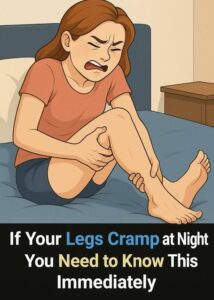Nighttime Leg Cramps: Who’s at the Greatest Risk?

Night leg cramps are sharp, involuntary muscle contractions that often strike without warning, usually in the middle of the night. These painful spasms can affect anyone but are especially common among older adults, pregnant women, athletes, and even those who spend long hours sitting or standing still.
The causes are often tied to muscle overuse, poor blood circulation, or imbalances in key minerals like magnesium, potassium, and calcium — all of which help muscles function properly. When these levels drop or circulation slows, muscles can tighten unexpectedly, leading to those sudden nighttime jolts.
Older adults are particularly at risk due to natural changes that come with aging — reduced muscle elasticity, slower nerve responses, and less efficient blood flow. These factors make cramps more frequent and more painful. Pregnant women, especially in later stages, may experience them because of hormonal changes, increased weight, and added pressure on the legs.
Active individuals and athletes can also suffer from night cramps when intense workouts drain electrolytes and overwork muscles. On the other hand, people with sedentary lifestyles face the opposite problem: long periods of sitting or standing that limit circulation.
Certain health conditions — such as diabetes, thyroid or kidney issues, peripheral artery disease, and some neurological disorders — can further increase the risk. In addition, medications like diuretics, statins, and certain asthma or birth control pills may contribute by altering hydration and mineral levels.
To help prevent nighttime cramps, experts recommend:
-
Drinking enough water throughout the day
-
Stretching the calves, hamstrings, and feet before bed
-
Maintaining a balanced diet rich in minerals
-
Staying physically active to boost circulation
-
Sleeping in positions that don’t restrict blood flow
While an occasional cramp is usually harmless, frequent or severe episodes — especially when accompanied by swelling, redness, or changes in the skin — should be checked by a healthcare provider. Early attention can uncover underlying health issues and lead to effective treatment.
With simple daily habits and greater awareness, it’s possible to ease the frequency of these painful cramps — leading to better, more peaceful sleep and healthier muscles overall.